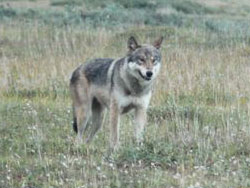Living With Wolves
 Wolves are common over much of Alaska, especially in non-urbanized areas. They are the wild ancestors and genetic source of all
modern breeds of domesticated dog. Their life history is both familiar to many of us and quite distinct from that of their domesticated brethren.
Wolves are common over much of Alaska, especially in non-urbanized areas. They are the wild ancestors and genetic source of all
modern breeds of domesticated dog. Their life history is both familiar to many of us and quite distinct from that of their domesticated brethren.
Living and Camping in Wolf Country
Because wolves are widespread, thousands of people live, work and enjoy outdoor activities in wolf country. Wolves rarely act aggressively toward people, but there have been instances in Alaska and Canada where wolves have attacked people. The first case of wild healthy wolves killing a human in modern North America occurred in Saskatchewan in 2005; a second person was killed in 2010 in Alaska. Several other incidents of wolf aggression have resulted in serious injuries. Some people in recent years have even had worrisome encounters with wolves while in suburban settings.
People enjoying wilderness activities must be aware that all large wild animals, including wolves, present some risk to human safety. When you go into the wilderness, which in many Alaskan cities is just outside your back door, go prepared. It’s safer to travel with someone else rather than alone. In our urban environments we often don’t pay much attention to what goes on around us, but a key to safety in the wild is awareness. Develop a habit of scanning your surroundings, don’t become so focused on an activity that you put yourself at risk for a close encounter with a mother moose, bear, or curious wolf. Naturally you should closely tend children and pets, maintain clean camps and do not store food where it is accessible to wild animals.
Hearing a howling wolf or seeing a traveling wolf pack can be an exhilarating wilderness experience and should be enjoyed, but everyone who leaves the beaten path behind must take on the responsibility to ensure their own safety.
Safety in Wolf Country
 If you encounter a wolf or pack of wolves at close range do not run or turn away. If you are approached, act aggressively and
maintain eye contact if the wolf is looking at you. Aggressively use poles, pepper spray, rocks, limbs, noisemakers or other
handy items to discourage wolves. Carrying a firearm is not a bad idea, but do so only if you are qualified and comfortable
with the use of your firearm, and if you are in an area that allows firearms.
If you encounter a wolf or pack of wolves at close range do not run or turn away. If you are approached, act aggressively and
maintain eye contact if the wolf is looking at you. Aggressively use poles, pepper spray, rocks, limbs, noisemakers or other
handy items to discourage wolves. Carrying a firearm is not a bad idea, but do so only if you are qualified and comfortable
with the use of your firearm, and if you are in an area that allows firearms.
Don’t make your home or camp attractive to wolves, follow clean camping guidelines.
In the rare event that you do have an encounter with an aggressive wolf:
- Don’t run, but act aggressively stepping toward the wolf and yelling or clapping your hands if it tries to approach.
- Do not turn your back toward an aggressive wolf, but continue to stare directly at it. If you are with a companion and more than one wolf is present, place yourselves back to back and slowly move away from the wolves.
- Retreat slowly while facing the wolf and act aggressively.
- Stand your ground if a wolf attacks you and fight with any means possible (use sticks, rocks, ski poles, fishing rods or whatever you can find).
- Use air horns or other noisemakers.
- Use bear spray or firearms if necessary.
- Climb a tree if necessary; wolves cannot climb trees.
Report dangerous wolf situations to ADF&G using the wildlife encounter form.
Additional Links
- Wolf Safety in Alaska: How to live safely in wolf country (PDF 155 kB)
- Living With Wolves (rack card) (PDF 376 kB)
